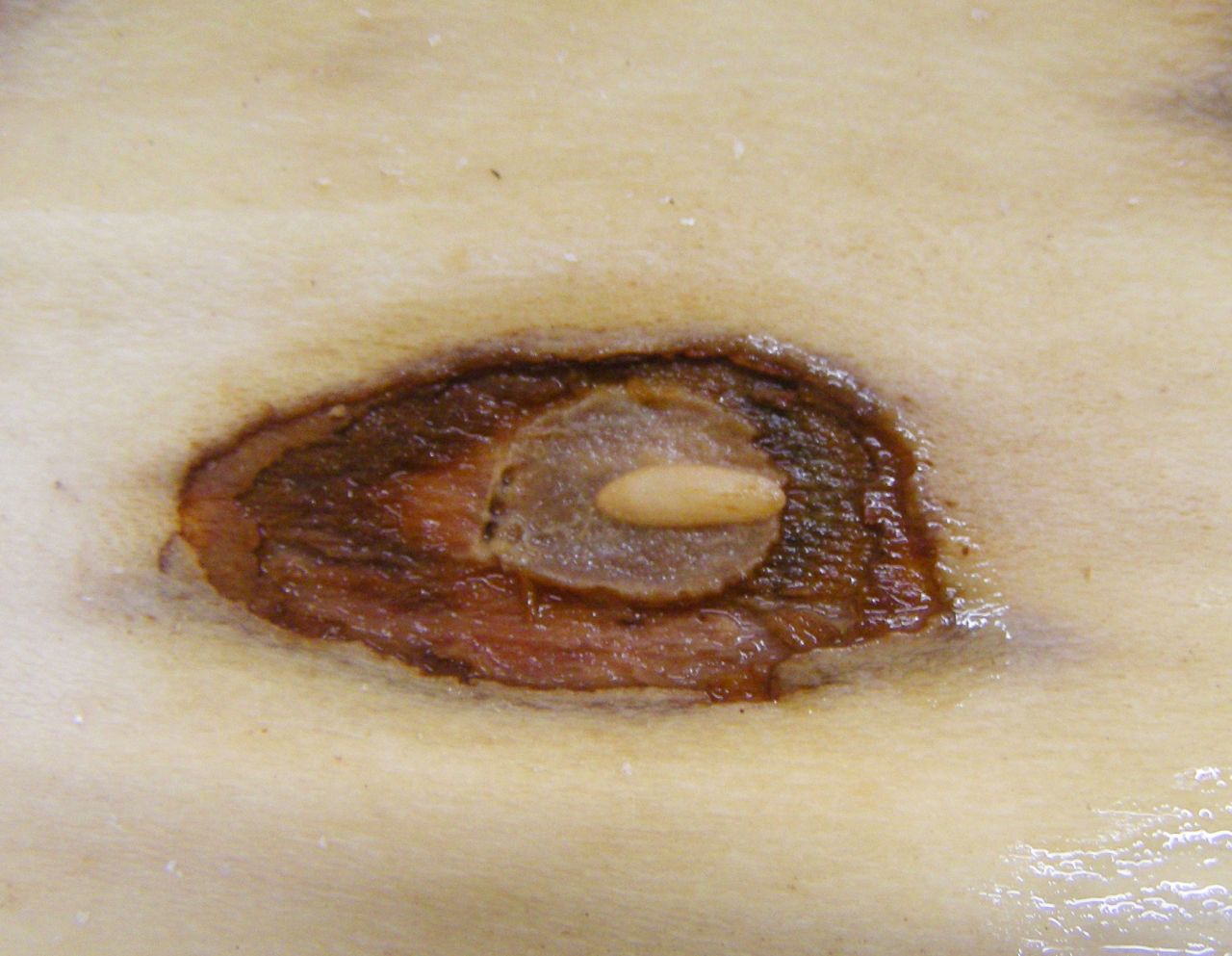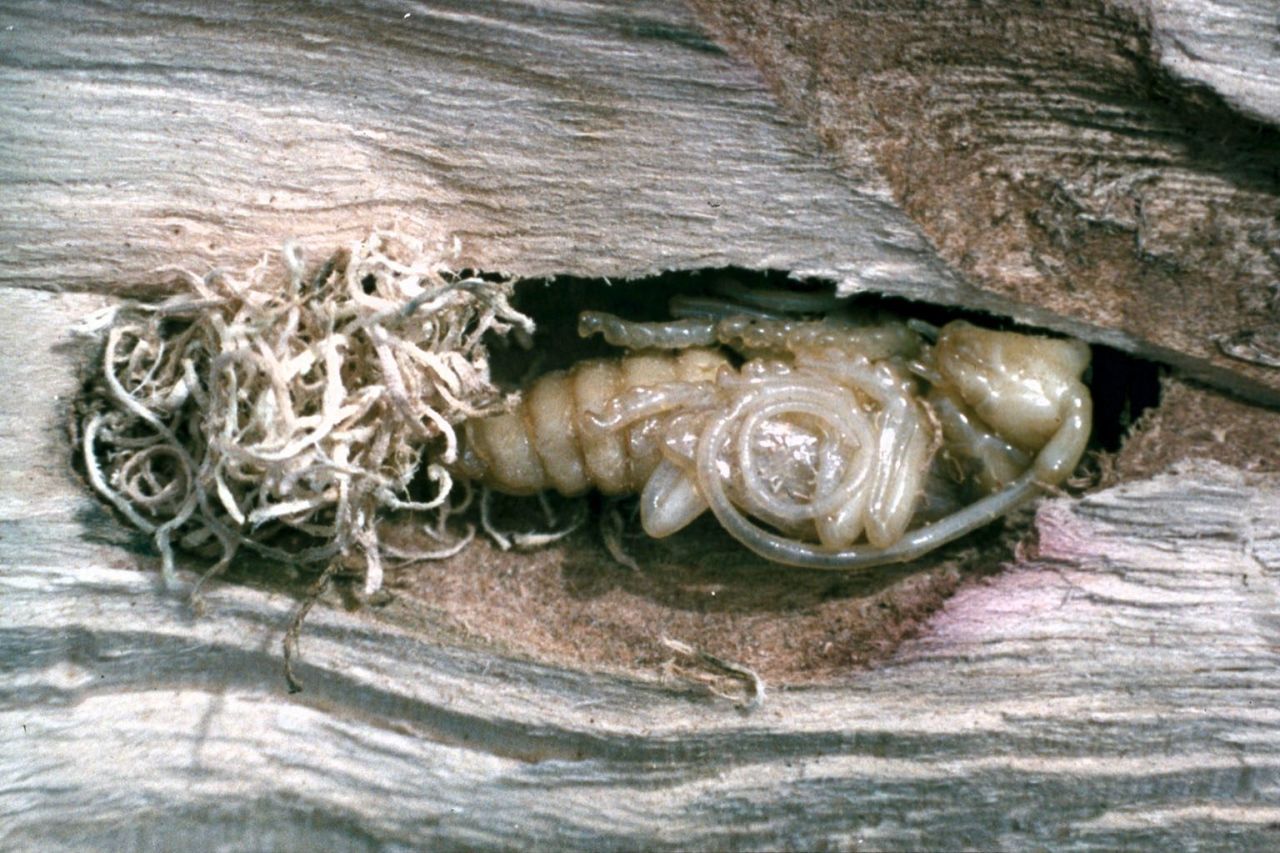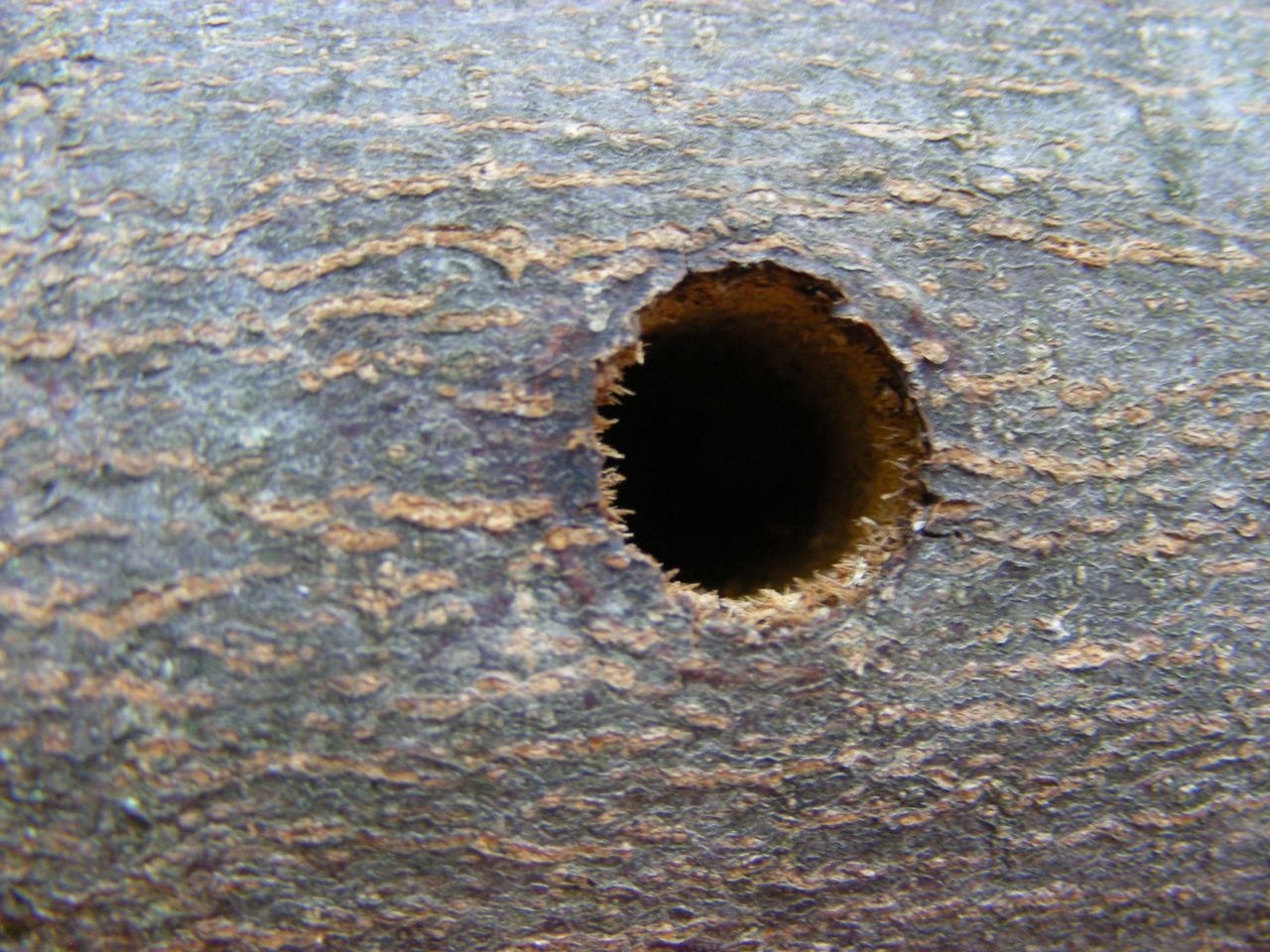A threat for forests: The asian longhorned beetle
In 2001, this quarantine pest*, which is classified as particularly harmful, was detected for the first time in Europe. Since then, new infestations have been confirmed in at least 11 European countries. Most of the outdoor infestations have been eradicated but some are still under observation and new infestations can be expected at any time. So be vigilant!
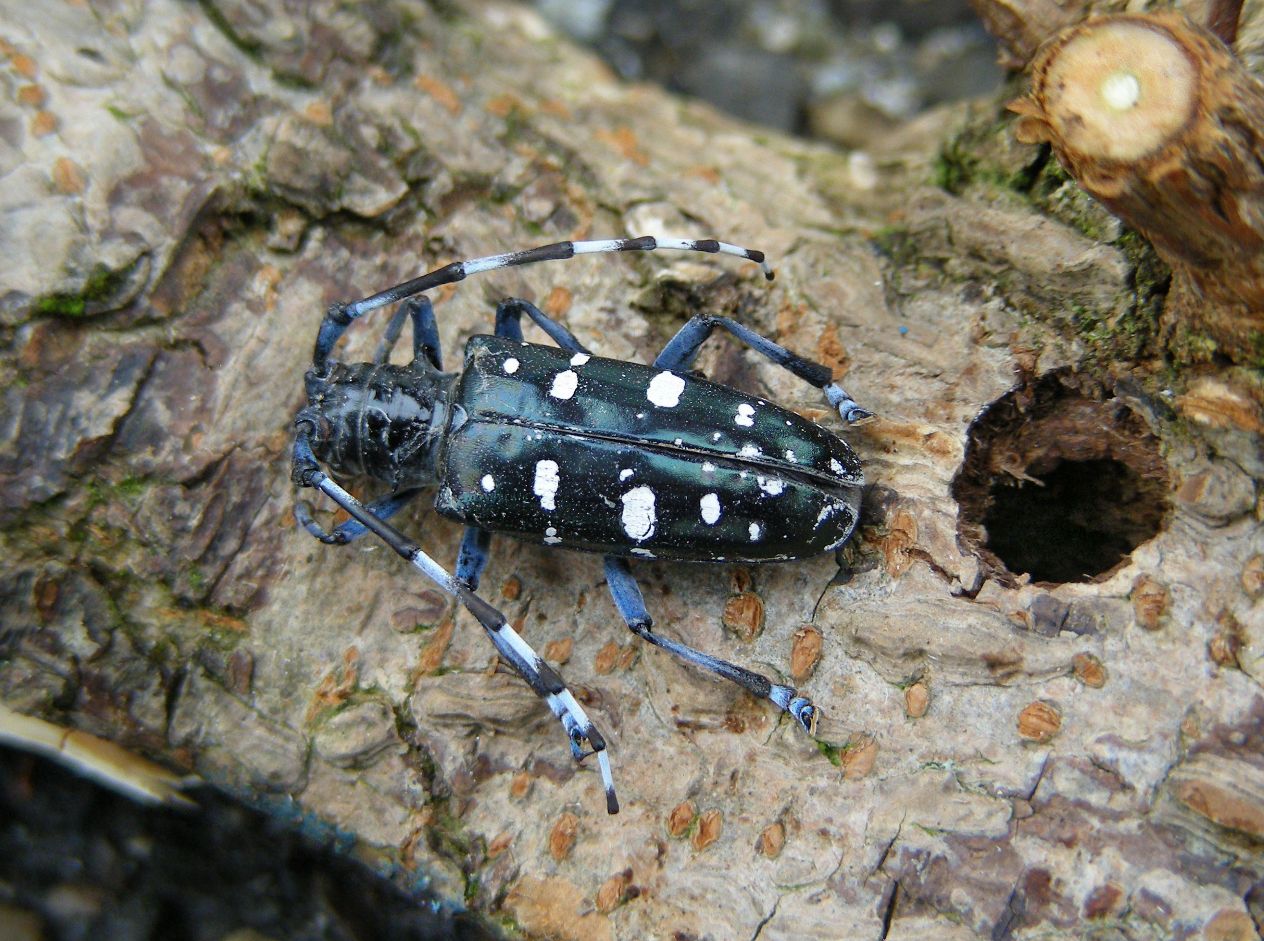
A newly emerged Asian longhorned beetle next to its exit hole on a tree. Image: © Doris Hölling
Profile
- The glossy black adults are 17–40 mm long and have white or yellow irregular spots on their smooth elytra (the hardened forewings that cover the soft hindwings). Each long antenna has 11 segments. Each segment is blue-white at the base, changing to black towards the top.
- They are native to Korea and eastern China and entered North America and Europe inside wooden packaging used e. g. for shipping granite from China.
- The non-native Asian longhorned beetle (ALB) infests different species of native healthy hardwood trees and can cause dieback* within just a few years. In Europe, affected trees are often maple, horse chestnut, birch, poplar, willow and elm. Theoretically, all hardwood species can be infested!
- ALBs can be detected by the traces they leave: circular exit holes with a diameter of 8–13 mm; egg-laying sites – slit or funnel-shaped – in the bark; feeding damage on twigs and leaf stalks caused by adults.
Classification
- Kingdom
- Animalia
- Phylum
- Arthropoda
- Class
- Insecta
- Order
- Coleoptera
- Family
- Cerambycidae
- Genus
- Anoplophora
- Species
- A. glabripennis
In Europe, the life cycle of the Asian longhorned beetle lasts two years. The adults are active from April to October/November. Although the beetles can only lay their eggs in living wood, the larvae in the wood can survive the felling of the tree and its processing, allowing the larvae to later develop in the resulting wood packaging.
The feeding activity of the larvae in the tree trunk destroys the water and nutrients transport system in the wood, which leads to the dieback of branches or, in the case of large infestations, to the death of the tree.
Detection
To detect the invader in Europe as early as possible, numerous import controls and controls of warehouses and nurseries or garden centers are carried out in Switzerland every year on behalf of the Federal Office for the Environment (FOEN), whereby ALB sniffer dogs are also used. In addition, there is an annual area monitoring throughout Switzerland using traps with special pheromones as part of Europe-wide controls of quarantine pest organisms (A1 Quarantine pest (Annex II A)). This monitoring is being carried out by the Swiss Forest Protection on behalf of the FOEN and together with the cantons.
Besides arborists and tree climbers, specially trained sniffer dogs are successfully deployed for ALB detection.

A trained sniffer dog is barking under a tree, indicating the presence of ALBs. Image: © Verband Spürhundewesen Schadorganismen Schweiz
In the case of an ALB report, Swiss Forest Protection takes over the identification of the beetles, larvae or eggs, including genetic analysis, and supports the FOEN and the cantons concerned in managing this priority quarantine pest.
ALBs in Switzerland
Find more information about the current infestation status in Switzerland on this website, which is updated regularly. https://www.waldwissen.net/en/forestry/forest-protection/invasive-species/the-asian-longhorned-beetle-in-europe#c105047
Citizen responsibilities
As Asian longhorned beetles threaten our deciduous trees, we are all required to report infestations to the cantonal authorities (Kantonale Pflanzenschutzdienste, KPSD) or the responsible cantonal forest protection service (WSB).
The responsible cantonal authorities will take necessary measures to eradicate the infestation. An infested area can only be declared free of infestation if no ALB is detected within four consecutive years.
Risk of confusion
ALBs are very similar to our native Monochamus species and are often misidentified. Therefore, experts are required to validate these reports to prevent unnecessary precautions due to false alarms.
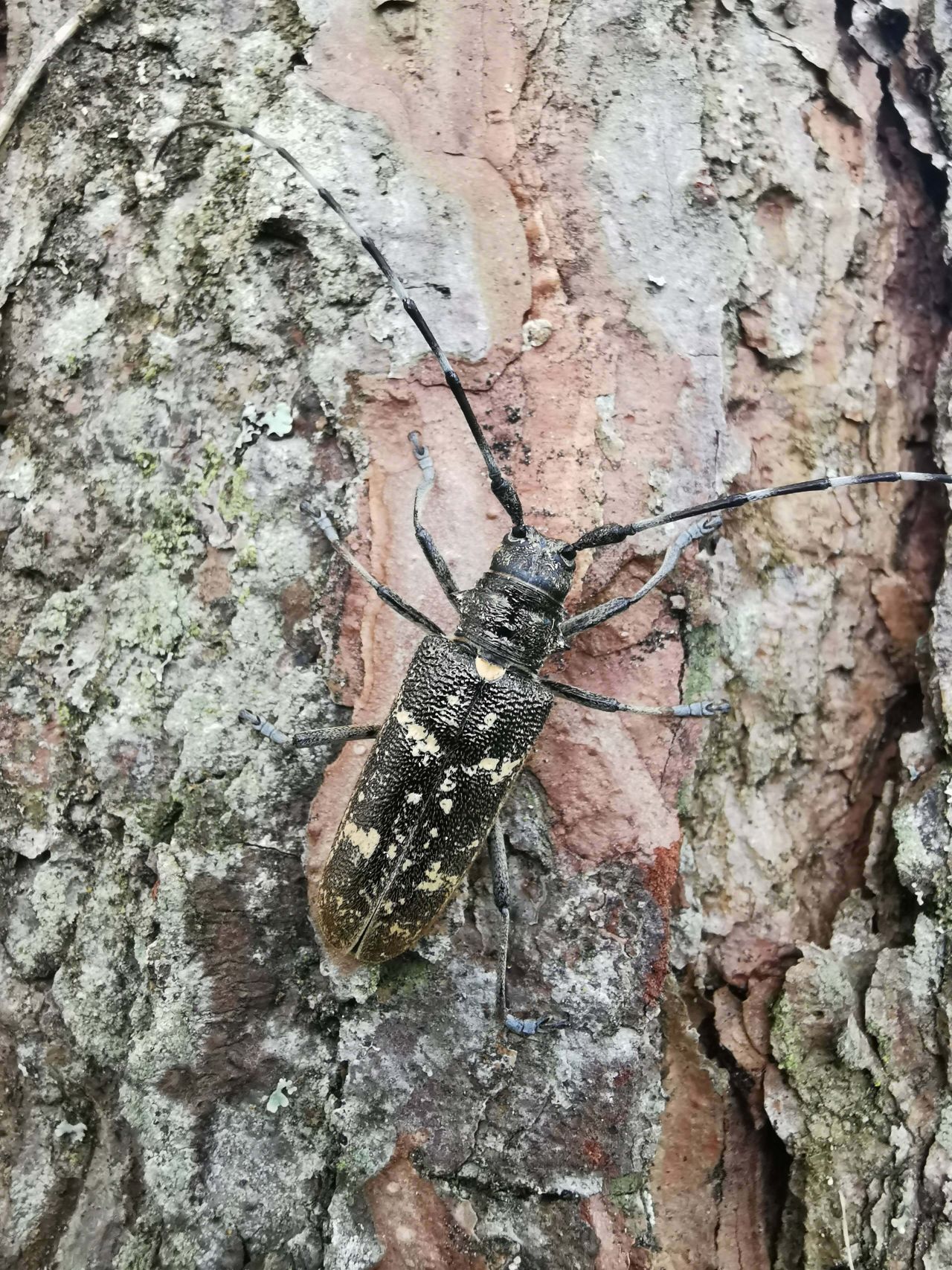
Monochamus sutor beetle walking on a tree. Image: © Doris Hölling
Catching them with trapping trees
If their host tree is disturbed, the beetles fly away and escape. However, they don't fly very far and tend to return to the same area. As the beetles can only be controlled by removing their habitat, all infested host trees must be felled. To catch the beetles that return after felling, uninfested “trapping trees” in plant pots are placed where host trees have been felled. These trapping trees attract the returning beetles, which settle and lay their eggs there. After 1.5 years, before a new generation of beetles can develop and emerge, these trapping trees are destroyed as well. This method is very effective.
Practical tips
- Asian longhorned beetles have strong mouthparts and can chew themselves out even from thin plastic containers or bags. So, if you find one, please always keep it in a jar with a lid until you hand it over to a specialist!
- Be careful when you handle an ALB as it might bite you!
*Glossary
Dieback: Tree dieback is the gradual deterioration in the health of trees, sometimes leading to the death of the tree.
Quarantine pest: Quarantine pests are plant diseases or pests of potential economic significance which are not present or only occur locally in Switzerland. They are subject to a general notification and control obligation. More info: https://www.blw.admin.ch/blw/en/home/nachhaltige-produktion/Pflanzengesundheit/schaedlingeundkrankheiten/quarantaeneorganismen.html
References
Factsheet Waldschutz Schweiz. Asiatischer Laubholzbockkäfer (ALB): https://www.dora.lib4ri.ch/wsl/islandora/object/wsl%3A26028/datastream/PDF/H%C3%B6lling-2020-Asiatischer_Laubholzbockk%C3%A4fer_%28ALB%29._Anoplophora_glabripennis_Motschulsky-%28published_version%29.pdf (available also in Italian and French). Accessed 27.5.2024
Swiss Federal Research Institute WSL The Asian longhorned beetle in Europe: https://www.waldwissen.net/en/forestry/forest-protection/invasive-species/the-asian-longhorned-beetle-in-europe (continuously updated, available also in Italian and French) Accessed 27.5.2024
WSS. Asiatischer Laubholzbockkäfer (ALB): https://waldschutz.wsl.ch/de/gehoelzschaedlinge/asiatischer-laubholzbockkaefer-alb/ Accessed 27.5.2024
Swiss Federal Research Institute WSL. Invasive Laubholz-Bockkäfer aus Asien. Ökologie und Management. Merkblatt für die Praxis: https://www.wsl.ch/de/publikationen/invasive-laubholz-bockkaefer-aus-asien-oekologie-und-management/ (available also in Italian and French) Accessed 27.5.2024Bundesamt für Umwelt BAFU, Bundesamt für Landwirtschaft BLW, WSL. Bestimmungshilfe Asiatische Laubholzbockkäfer: https://www.bafu.admin.ch/bafu/de/home/themen/wald/publikationen-studien/publikationen/bestimmungshilfe-asiatische-laubholzbockkaefer.html A(available also in Italian and French) Accessed 27.5.2024
EPPO Global Database. Anoplophora glabripennis (ANOLGL). https://gd.eppo.int/taxon/ANOLGL Accessed 27.5.2024
